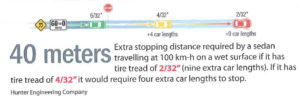The safe stopping distance of your vehicle is directly related to your tire tread depth. Tread depth is a vertical measurement between the top of the tread rubber to the bottom of the tire’s deepest grooves. Tread depth is measured in 32nds of an inch. New tires on new cars measure 10/32 inches to 11/32 inches.
When your tires get worn to a depth of 2/32, they are considered “worn-out”. In fact, according to a recent study, while the National Highway Traffic Safety Administration (NHTSA – USA) found that nearly 26 percent of the tires with tread depths of zero to 2/32 inch contributed to crashes, eight percent of the tires with 3/32 to 4/32-inch tread depth also created problems in crashes.
Because tires have the greatest effect on the way a vehicle handles and brakes, it is unwise to wait to replace tires. Without traction (good tread depth), a car will not respond to the steering wheel or the brakes, presenting serious safety concerns. Sufficient tread depth reduces hydroplaning on snowy, slushy and wet roads, affects stopping distance and helps prevent accidents.
This graphic shows that stopping distances on a wet surface comparing tread depths of 2/32 and 4/32. See for yourself.

